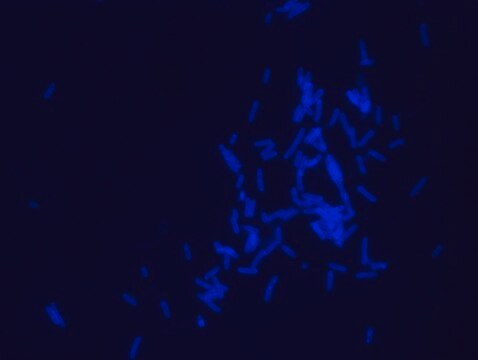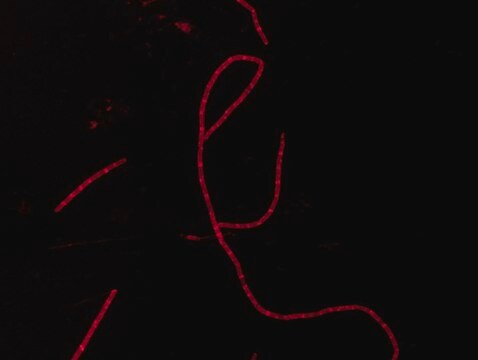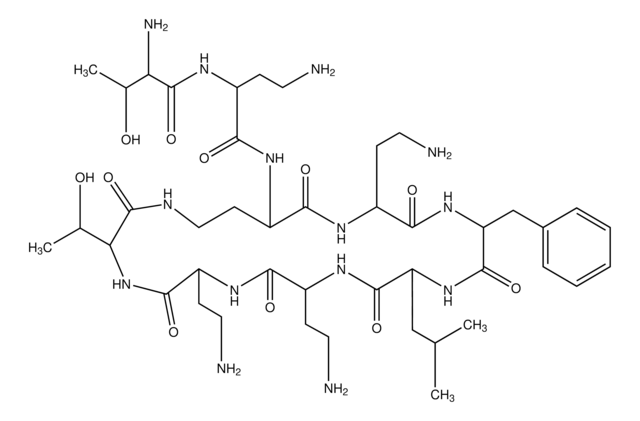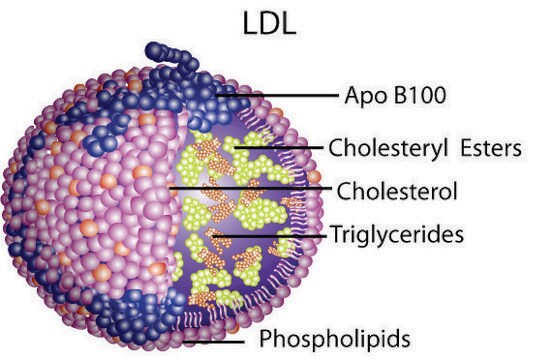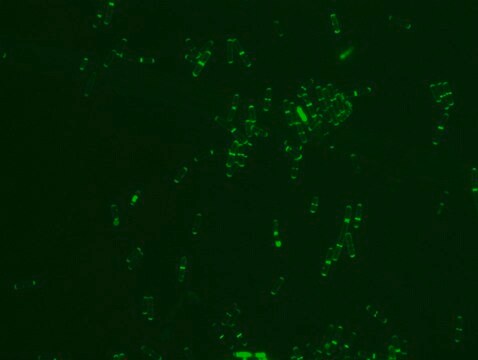SBR00036
Rhodamine B labeled Polymyxin B Ready Made Solution
For fluorescent microbial imaging, 1.1 mg/mL in water
Sinônimo(s):
SRB-PMB
Faça loginpara ver os preços organizacionais e de contrato
About This Item
Código UNSPSC:
12352211
NACRES:
NA.47
Produtos recomendados
Nível de qualidade
concentração
1.1 mg/mL in water
tipo de lipídio
saturated FAs
temperatura de armazenamento
−20°C
Categorias relacionadas
Descrição geral
Rhodamine B labeled polymyxin B (SRB-PMB) is a fluorescent derivative of Polymyxin B. Rhodamine B polymyxin B is an additional fluorescent derivative of Polymyxin B, along with Dansyl labeled polymyxin B (Product # SBR00029). Both products′ mode of action is in accordance with Polymyxin B activity. Fluorescent antibiotics are obtained by synthetic conjugation of an antibiotic to a fluorophore.
Aplicação
Fluorescent antibiotics can be used for many applications including:
Additional possible applications for Rhodamine B labeled Polymyxin B:
- Antimicrobial resistance research.
- Bacterial visualization and imaging.
- Parent antibiotic mode of action research and new antibiotic discovery.
- Toxicity studies.
- Research of bacterial infections and tracking its uptake in vivo.
Additional possible applications for Rhodamine B labeled Polymyxin B:
- Evaluate LPS binding by FRET (fluorescence resonance energy transfer) studies to form a specific complex between fluorescein (FITC)-tagged LPS and Polymyxin B, indicating direct binding of the antibiotic to the LPS
- Can be applied as a fluorescent probe to study polymyxin mode of action and its pharmacokinetics
- to assess the mitochondrial function of polymyxin B in a kidney cell line (LLC-PK1), suggesting that it changes the mitochondrial membrane polarization.
Nota de análise
- Rhodamine B labeled polymyxin B Ready Made Solution is light sensitive.
- It is recommended to avoid freeze-thaw cycles of Rhodamine B labeled polymyxin B Ready-Made Solution
- Rhodamine B labeled polymyxin B Ready Made Solution (1.1mg/mL) can be diluted 1:100-200 in PBSX1 (Product# D8537) to achieve 0.55-1.1μg/mL final concentration for staining. The above concentration of Rhodamine B labeled polymyxin B was used for Escherichia coli staining (see image)
- Fluorescence Microscopy application: Rhodamine B labeled polymyxin B Ready Made Solution excitation (Ex) wavelength is 550-560nm resulting in emission (Em) range of 580-610nm (λmax=590-600nm)
Código de classe de armazenamento
12 - Non Combustible Liquids
Classe de risco de água (WGK)
WGK 1
Ponto de fulgor (°F)
Not applicable
Ponto de fulgor (°C)
Not applicable
Escolha uma das versões mais recentes:
Certificados de análise (COA)
Lot/Batch Number
It looks like we've run into a problem, but you can still download Certificates of Analysis from our Documentos section.
Se precisar de ajuda, entre em contato Atendimento ao cliente
Já possui este produto?
Encontre a documentação dos produtos que você adquiriu recentemente na biblioteca de documentos.
P R Schindler et al.
Antimicrobial agents and chemotherapy, 8(1), 95-104 (1975-07-01)
Though the primary action of the cationic antibiotic polymyxin B is against the membrane of susceptible bacteria, severe morphological changes are detected in the cytoplasm. Using fluorescence microscopy and a mono-N-dansyl-polymyxin B derivative, we could demonstrate aggregations of the antibiotic
Vincent H Tam et al.
Antimicrobial agents and chemotherapy, 49(9), 3624-3630 (2005-08-30)
Despite limited data, polymyxin B (PB) is increasingly used clinically as the last therapeutic option for multidrug-resistant (MDR) gram-negative bacterial infections. We examined the in vitro pharmacodynamics of PB against four strains of Pseudomonas aeruginosa. Clonal relatedness of the strains
R E Hancock
Lancet (London, England), 349(9049), 418-422 (1997-02-08)
The era of the "classical antibiotic" may be over. The emergence of resistance has seen to that. Yet no truly novel class of antibacterial agent has come on the market in the past 30 years. Currently there is great interest
M E Evans et al.
The Annals of pharmacotherapy, 33(9), 960-967 (1999-09-24)
Polymyxin B sulfate and colistin, also known as colistimethate, have not been used for many years because less toxic antimicrobials are available. Gram-negative bacteria that are resistant to the aminoglycosides, beta-lactams, and fluoroquinolones are becoming more common. These bacteria are
Global Trade Item Number
| SKU | GTIN |
|---|---|
| SBR00036-0.5ML | 4065266258875 |
Nossa equipe de cientistas tem experiência em todas as áreas de pesquisa, incluindo Life Sciences, ciência de materiais, síntese química, cromatografia, química analítica e muitas outras.
Entre em contato com a assistência técnica